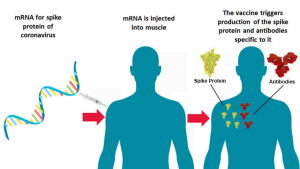The development of mRNA vaccine technology
Messenger RNA (mRNA) vaccines are important molecules that are essential in human cells to link the DNA and all biological functioning in an individual. Scientists developed the process by using the messenger rather than the actual part of the virus or bacteria. For protein production, messenger RNA is utilized. This technology was developed to create new development in vaccines to treat diseases like cancer, rare diseases and mediated diseases. mRNA is a potential method used to develop the vaccines against the SARS-COV-2 virus that caused COVID-19. Vaccines consist of a small segment of the virus to combat the infectious disease while mRNA takes the information. It creates a mimic to produce the proteins and when the protein gets developed it breaks down further into messenger RNA. It is used as a unique protein that would enter the cells to instruct the blood cells and DNA to fight against viral infection. mRNA is the intermediary step between protein casein DNA translation and protein creation in the cytoplasm by a ribosome. Virally generated mRNA and Non-replicating; RNA self-amplifying are the two forms of RNA now being researched as vaccines.
Approach for mRNA vaccine technology
In this approach, the vaccines mimic the virus and teach the cells to become self-dependent in the production plants of vaccines that offer benefits in the production speed and can keep up with the new mutates or variants. This vaccine can fight other infectious diseases like flu, malaria, etc. To fight against the pandemic of Covid 19 the first development of a vaccine has been done using mRNA technology. Many companies are using complete S glycoprotein with mRNA methodology to develop the vaccines for SARS-COV-2.
Process
When an mRNA vaccine is injected into the human body, The immune system recognizes that the protein is unfamiliar and creates specialized proteins known as antibodies as part section of a normal immunological response. Specifically, it begins the production of spike proteins and antibodies to fight against the identified virus. Like in the case of covid disease it began to produce the spike proteins around the SARS-COV 2 to curb the spread and effect in the body and builds an immune system through the antibody to prevent the severe impact of the virus in future if got assimilated in the blood. The in vitro generated mRNA is produced from plasmid DNA that contains an RNA polymerase activator and a sequence that matches the mRNA composition.
Advantage
mRNA developed vaccines don’t enter the nucleus of the cell and it also does not make any alteration in the DNA. Vaccines from the mRNA approach are quicker, effective and have better reliability than the traditional vaccines.
Examples:
Pfizer-BioNTech uses engineered genetically messenger RNA. It has also successfully created the S Glycoprotein with the mutation sites vaccine BNT162b2 mRNA.

Image source: weforum.org
Conclusion
Currently, mRNA technology-based vaccine development is approved to use only to create the vaccines for COVID-19. It showed promising results by developing an immune system to fight against such infectious diseases globally. Thus, mRNA-based vaccinations promise to be a game-changing technology platform that creates vaccines for therapeutic and prophylactic purposes after two decades of the first successful delivery to in-vivo mRNA. The scientists are currently anticipating the release of the first medical efficacy results. However, there are a lot of fields to analyze and bring improvement in the mRNA-based vaccine.

